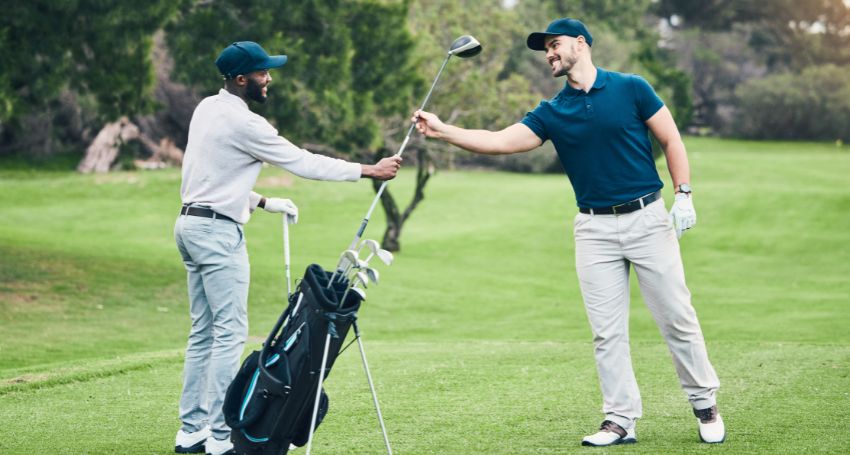A golf club fitting is a detailed and methodical process designed to optimize your golf equipment for your unique playing style, physical attributes, and performance goals. It ensures that your clubs are tailored to enhance your accuracy, consistency, and overall enjoyment of the game. Let’s break down the key components of what a professional golf club fitting consists of.
What Is Golf Club Fitting?
A golf club-fitting is the process of customizing your golf equipment to suit your unique swing and playing style. It involves working with a professional club fitter to analyze key aspects of your game, such as swing speed, ball flight, and shot dispersion. Using this data, the fitter adjusts or recommends new golf clubs that offer the proper fit for your needs.
Why Is Golf Club Fitting Important for Every Golfer?
No two golfers are alike, and club fitting ensures that your equipment complements your unique style of play. Benefits of a custom fit include:
- Improved Accuracy: Clubs are adjusted to minimize mishits and off-center strikes.
- Better Consistency: Customized settings help you achieve repeatable results.
- Enhanced Comfort: A well-fitted club reduces strain and promotes a natural swing.
Whether you’re a novice or a seasoned pro, a golf club fitting can drastically improve your performance.
Key Components of a Golf Club-Fitting
A typical fitting session includes the following steps:
- Static Measurements: Basic physical data like your height, wrist-to-floor distance, and hand size are taken.
- Swing Analysis: A club fitter evaluates your golf swing using high-tech tools.
- Club Adjustments: Elements like shaft length, lie angle, and grip size are customized.
- Testing: You try out various types of golf clubs to determine the best fit for your game.
What Data Does a Club Fitter Analyze?
During a club fitting, the fitter examines multiple factors to optimize your clubs. These include:
- Swing Speed: Determines the flexibility of the shaft.
- Ball Flight: Helps adjust the loft and lie of your clubs.
- Spin Rate: Affects shot trajectory and distance.
- Grip Size: Ensures a comfortable and secure hold.
By analyzing these metrics, the fitting professional ensures your clubs enhance your strengths and mitigate weaknesses.
How Technology Enhances the Fitting Process
Modern club fitting relies heavily on advanced tools and technology. Key innovations include:
- Launch Monitors: Launch monitor devices like TrackMan measure golf ball speed, launch angle, and spin rate.
- Fitting Bays: Indoor setups that simulate real-world conditions for precise analysis.
- Clubhead Sensors: Track how your swing interacts with the club head.
These tools provide accurate data that helps fitters tailor your clubs to your exact specifications.
What Happens During a Fitting Session?
A fitting session typically follows these steps:
- Assessment of Current Clubs: The club fitter evaluates your existing equipment to identify gaps or issues.
- Swing Testing: Using your current clubs, the fitter records data on your swing dynamics.
- Customization: The fitter adjusts or recommends clubs based on the analysis, focusing on aspects like club length and loft and lie.
- Testing New Clubs: You try out potential options to see which one feels and performs best.
The result is a set of custom-fit golf clubs that optimize your game.
How to Prepare for a Golf Club-Fitting
Maximize your fitting experience by following these tips:
- Bring Your Current Clubs: This allows the fitter to compare your performance with your existing set.
- Wear Golf Shoes: Replicate your actual golf game conditions during testing.
- Know Your Goals: Whether it’s more distance or accuracy, communicate your objectives to the fitter.
A little preparation goes a long way in ensuring you get the most out of your fitting session.
Common Myths
Many golfers hesitate to schedule a club fitting due to misconceptions. Let’s clear up a few:
- “Club fitting is only for advanced players.” Not true—golfers of all skill levels benefit from properly fitted clubs.
- “Custom clubs are too expensive.” While they may cost more upfront, their long-term impact on your game makes them worth it.
- “Fitting takes too long.” Most sessions last between one and two hours, making them efficient and accessible.
Understanding the truth about golf club-fitting ensures you make informed decisions.
How Long Does a Golf Club Fitting Take?
A typical fitting session lasts about 60 minutes, though this can vary depending on the type of golf club being fitted. For example:
- Putter Fitting: Usually takes about 30–45 minutes.
- Full Bag Fitting: This may take up to two hours.
The time investment is small compared to the lasting benefits of having a properly fitted set.
Why Invest in a Custom Golf Club-Fitting?
A custom golf club fitting is an investment in your passion for golf. Here’s why it’s worth it:
- Enhanced Performance: Gain consistency and confidence with every swing.
- Tailored to You: Your clubs are adjusted to your unique needs and goals.
- Long-Term Value: Fitted clubs often last longer and perform better over time.
Whether you’re purchasing a new set or adjusting your current clubs, the value of a custom fit cannot be overstated.





























































